Related Research Articles

Shinsuke Suematsu is a Japanese politician who serves as a member of the House of Councillors in the Diet of Japan. He has represented the Hyogo at-large district as a member of the Liberal Democratic Party since 2004. He served as Minister of Education, Culture, Sports, Science and Technology from 2021 to 2022.
Yuko Sato is a Japanese politician and member of the Genzei Nippon party. She previously served one term in the House of Representatives of Japan's national Diet and currently serves on the Nagoya city council in Aichi Prefecture.

Akihiro Ota is a Japanese politician of the Komeito Party and a former member of the House of Representatives in the National Diet. Ota represented three districts within the Tokyo metropolis since he first entered the Diet in 1993. He served as chief representative of the Komeito Party from 2006 until the general election in September 2009, at which time he lost his seat in the Diet. Upon his return to the House in December 2012, Ota was appointed as the Minister of Land, Infrastructure, Transport and Tourism, a post he held until October 2015.

Ai Aoki is a Japanese politician and current member of the People's Life Party. She is a native of Tokyo and graduate of Chiba University. After a career in education, Aoki entered politics in 2003 and has served a total of four terms in the national Diet of Japan, having sat in the House of Representatives from 2003 to 2005 and 2009–2014, and a partial term in the House of Councillors from 2007 to 2009. Aoki was returned to the House of Councillors in the election held on 10 July 2016.

Tokyo 6th district is a constituency of the House of Representatives in the Diet of Japan. It is located in Tokyo, and consists of a part of Setagaya, one of Tokyo's 23 special wards. With 2.18 times as many voters as Tokushima's 1st district, it had the lowest electoral weight throughout Japan in the election of 2005. In 2007 the Supreme Court dismissed a claim that the election in this and other Tokyo districts was unconstitutional and thus invalid. As of September 2012, 486,353 eligible voters were registered in the district, giving them the third lowest electoral weight in the country.

The Kanagawa at-large district is a constituency of the House of Councillors in the Diet of Japan represented by six Councillors. It comprises the entire prefecture of Kanagawa and elects three Councillors every three years by single non-transferable vote.
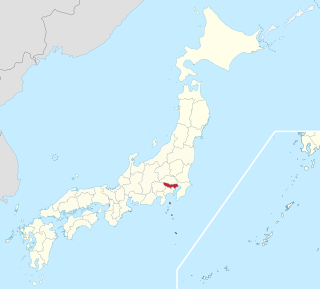
Tokyo at-large district is an electoral district of the House of Councillors in the National Diet, the national legislature of Japan. The district was created in 1947 by the new Constitution of Japan and sent 8 members to the House from 1947 until 2007. From 2007 until 2016, this district sent 10 members to the House, and from 2016 onwards, the district has sent 12 councillors to the House, making it by far the largest constituency in the House of Councillors.

The Tokyo 3rd district is a constituency of the House of Representatives in the Diet of Japan. It is located in Tokyo and encompasses Shinagawa ward and several outlying islands that belong to the Tokyo Metropolis.

Tokyo 10th district is a constituency of the House of Representatives in the Diet of Japan. As of 2012, 351,821 eligible voters were registered in the district. The district is located in the central area of the former city of Tokyo. After redistricting in 2022 it comprises the wards of Toshima and Bunkyō. Previously it had covered Toshima and a part of Nerima ward.

Tokyo 1st district is a constituency of the House of Representatives in the Diet of Japan. It is located in eastern mainland Tokyo and covers central parts of the former city of Tokyo. The district consists of the wards of Chiyoda and Shinjuku. As of 2016, 514,974 eligible voters were registered in the district. Before redistricting in 2022, the district included a part of Minato ward which is now in the 7th district.

Tokyo 2nd district is a constituency of the House of Representatives in the Diet of Japan. It is located in eastern mainland Tokyo and covers central parts of the former Tokyo City. The district consists of the wards of Chūō and Taitō. As of 2012, 424,273 eligible voters were registered in the district.

Tokyo 17th district is a constituency of the House of Representatives in the Diet of Japan. It is located in northeastern parts of the former city of Tokyo and covers the ward of Katsushika. Before redistricting in 2022 it also included parts of Edogawa ward. As of 2012, 440,965 eligible voters were registered in the district.
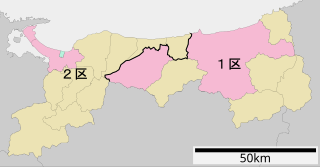
Tottori 1st district is a parliamentary constituency in Tottori Prefecture that was created in 1994. It has been represented in the House of Representatives of the National Diet of Japan since 1996 by Shigeru Ishiba, the Prime Minister and President of the Liberal Democratic Party since 2024.

Tōkyō 25th district is a constituency of the House of Representatives in the Diet of Japan. It is located in the westernmost part of Tokyo prefecture. In of 2012, 321,319 eligible voters were registered in the district giving it the highest vote weight in Tokyo – several districts in former Tokyo city in Eastern Tokyo have more than 450,000 voters – but still more than 1.5 times as many voters as the least populated electoral districts in Japan.
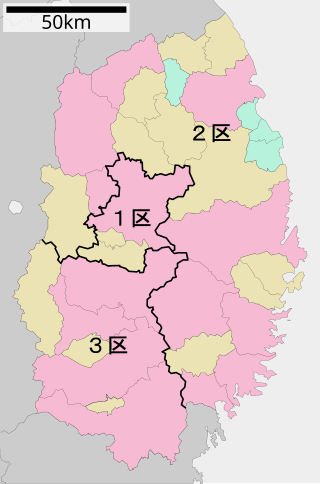
Iwate 1st district is a single-member constituency of the House of Representatives in the Diet of Japan. It is located in central Iwate and consists of the prefectural capital Morioka city and the two remaining towns in Shiwa district. Before 2017, it covered of the majority of the prefectural capital Morioka and Shiwa district. In 2012, 278,860 eligible voters were registered in the district.

The Yamagata at-large district is a constituency that represents Yamagata Prefecture in the House of Councillors in the Diet of Japan. Councillors are elected to the house by single non-transferable vote (SNTV) for six-year terms. Since the establishment of the current House of Councillors electoral system in 1947, the district has elected two Councillors, one each at elections held every three years. It has 937,920 registered voters as of September 2015.
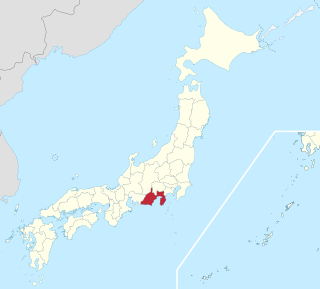
The Shizuoka at-large district is a constituency that represents Shizuoka Prefecture in the House of Councillors in the Diet of Japan. It has four Councillors in the 242-member house.

The 2016 Tokyo gubernatorial election took place on 31 July 2016 to elect the successor to Governor Yoichi Masuzoe, who submitted his resignation to the Tokyo Metropolitan Assembly on 15 June 2016. By-elections in four of Tokyo's cities were held on the same day to fill vacancies in the Assembly.
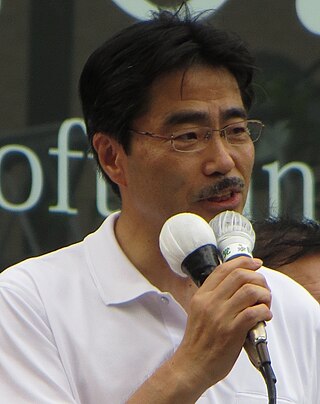
A by-election for the Tokyo 10th district in the Japanese Japanese House of Representatives was held on 23 October 2016 to replace Yuriko Koike, who vacated the seat to contest the Tokyo gubernatorial election in July 2016. Koike, a member of the Liberal Democratic Party (LDP), had represented the district since the December 2012 general election and also served a previous term from 2005 to 2009. The election was won by LDP candidate Masaru Wakasa, an incumbent member for the Tokyo proportional representation block who had supported Koike during her gubernatorial campaign. A separate by-election for the Fukuoka 6th district was held on the same day.
Akimasa Suzuki is a Japanese politician who is the Mayor of Ōta, a Special ward of Tokyo, since April 2023. A former member of the Tokyo Metropolitan Assembly, Suzuki was chairman of the Special Committee on Budget and Chairman of the General Affairs Committee.
References
- ↑ "東京都知事選挙及び東京都議会員補欠選挙(新宿区、台東区、大田区及び渋谷区の各選挙区)の選挙期日等の決定について" [About the determination of the election date for Tokyo gubernatorial election and Tokyo Metropolitan Assembly by-election (Shinjuku, Daito, Ota and Shibuya districts)](PDF) (in Japanese). Tokyo Electoral Commission. 17 June 2016. Retrieved 15 July 2016.
- 1 2 3 4 5 6 "東京都議会議員補欠選挙 候補者別得票数(全候補)" [Tokyo Metropolitan Assembly By-Election: Votes received per candidate (all candidates)](PDF) (in Japanese). Tokyo Electoral Commission. 31 July 2016. Retrieved 1 August 2016.
- ↑ "都議会議員選挙(平成21年7月12日執行)開票結果" [Tokyo prefectural election (12 July 2009) Results] (in Japanese). Tokyo Electoral Commission. Retrieved 15 July 2016.
- ↑ "東京都議会議員選挙(平成25年6月23日)開票結果" [Tokyo prefectural election (23 June 2013) Results] (in Japanese). Tokyo Electoral Commission. Retrieved 15 July 2016.
- 1 2 "東京都議会議員補欠選挙 開票結果内訳" [Tokyo Metropolitan Assembly By-Election Breakdown of Results](PDF) (in Japanese). Tokyo Electoral Commission. Retrieved 1 August 2016.
- 1 2 3 4 "東京都議会議員補欠選挙 投票結果" [Tokyo Metropolitan Assembly By-Election Turnout](PDF) (in Japanese). Tokyo Electoral Commission. Retrieved 1 August 2016.
- ↑ "平成27年4月26日執行 渋谷区長選挙開票速報" [26 April 2015 Shibuya Mayoral Election Results] (in Japanese). Archived from the original on 28 July 2016. Retrieved 15 July 2016.
- ↑ "服部 征夫(ハットリ ユクオ)自由民主党" [Yukuo Hattori LDP]. go2senkyo.com (in Japanese). Retrieved 15 July 2016.
- ↑ "平成27年3月1日執行 台東区長選挙" [1 March 2015 Taito Mayoral Election](PDF) (in Japanese). Taito Electoral Commission. p. 2. Archived from the original (PDF) on 16 August 2016. Retrieved 15 July 2016.